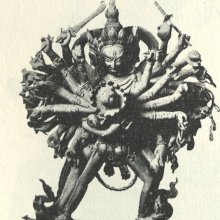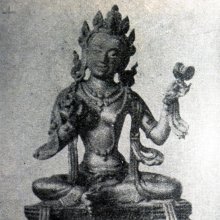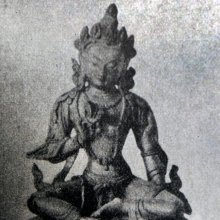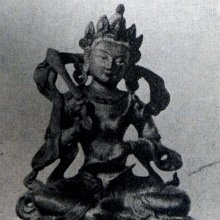Tanu, Tanū, Taṉu, Tāṉu: 27 definitions
Introduction:
Tanu means something in Buddhism, Pali, Hinduism, Sanskrit, the history of ancient India, Marathi, Jainism, Prakrit, Hindi, biology, Tamil. If you want to know the exact meaning, history, etymology or English translation of this term then check out the descriptions on this page. Add your comment or reference to a book if you want to contribute to this summary article.
Images (photo gallery)
(+2 more images available)
In Hinduism
Purana and Itihasa (epic history)
Source: archive.org: Puranic EncyclopediaTanu (तनु).—An ancient sage. This sage lived in the palace of King Vīradyumna for a long time. (Chapters 127 and 128, Śānti Parva).

The Purana (पुराण, purāṇas) refers to Sanskrit literature preserving ancient India’s vast cultural history, including historical legends, religious ceremonies, various arts and sciences. The eighteen mahapuranas total over 400,000 shlokas (metrical couplets) and date to at least several centuries BCE.
Ayurveda (science of life)
Source: archive.org: Vagbhata’s Ashtanga Hridaya Samhita (first 5 chapters)Tanu (तनु) refers to “thin”, as mentioned in verse 5.1-2 of the Aṣṭāṅgahṛdayasaṃhitā (Sūtrasthāna) by Vāgbhaṭa.—Accordingly, “[...] vitalizing, refreshing, pleasing one’s stomach, satisfying, stimulating one’s intellect, thin [viz., tanu], of indistinct taste, savoury, cold, light, (and) nectar-like (is) Ganges water fallen from the sky; (as it is), however, touched by sun, moon, and wind (in falling), it is largely dependent upon place and time so far as its wholesomeness and unwholesomeness are concerned”.
Source: gurumukhi.ru: Ayurveda glossary of terms1) Tanu (तनु):—Scanty, Thin. Transparent, Diluted, Delicate
2) [tanuḥ] Body

Āyurveda (आयुर्वेद, ayurveda) is a branch of Indian science dealing with medicine, herbalism, taxology, anatomy, surgery, alchemy and related topics. Traditional practice of Āyurveda in ancient India dates back to at least the first millenium BC. Literature is commonly written in Sanskrit using various poetic metres.
Jyotisha (astronomy and astrology)
Source: Wisdom Library: Brihat Samhita by VarahamihiraTanu (तनु, “small”) (or Madhyatanu, Cf. Tanumūrti) refers to a particular shape of the moon, according to the Bṛhatsaṃhitā (chapter 4), an encyclopedic Sanskrit work written by Varāhamihira mainly focusing on the science of ancient Indian astronomy astronomy (Jyotiṣa).—Accordingly, “Having thus described the shape of the moon we next proceed to describe her size (generally): if the moon should appear small there will be famine, and if big, prosperity, in the land. If the middle of the moon should appear small [i.e., madhya-tanu], there will be hunger in the land and princes will be afflicted with cares. If the middle should appear big she will cause prosperity and plenty”.

Jyotisha (ज्योतिष, jyotiṣa or jyotish) refers to ‘astronomy’ or “Vedic astrology” and represents the fifth of the six Vedangas (additional sciences to be studied along with the Vedas). Jyotisha concerns itself with the study and prediction of the movements of celestial bodies, in order to calculate the auspicious time for rituals and ceremonies.
Shaivism (Shaiva philosophy)
Source: Brill: Śaivism and the Tantric TraditionsTanu (तनु) refers to the “body”, according to the Mṛgendrāgama Kriyāpāda verse 8.6-7.—Accordingly, “The śivadharmiṇī [initiation] is the root of success for the fruits of the Śaiva religion for the individual soul. There is another [kind of śivadharmiṇī] taught without the destruction of the body (tanu), up until the dissolution of the world. The remaining one is taught to be the lokadharmiṇī, for the purpose of [attaining the eight-fold supernatural powers] starting with aṇimā after the current life, after all the bad portions [of karma] were destroyed at all reality levels”.

Shaiva (शैव, śaiva) or Shaivism (śaivism) represents a tradition of Hinduism worshiping Shiva as the supreme being. Closely related to Shaktism, Shaiva literature includes a range of scriptures, including Tantras, while the root of this tradition may be traced back to the ancient Vedas.
Ganitashastra (Mathematics and Algebra)
Source: archive.org: Hindu Mathematics1) Tanu (तनु) represents the number 1 (one) in the “word-numeral system” (bhūtasaṃkhyā), which was used in Sanskrit texts dealing with astronomy, mathematics, metrics, as well as in the dates of inscriptions and manuscripts in ancient Indian literature.—A system of expressing numbers by means of words arranged as in the place-value notation was developed and perfected in India in the early centuries of the Christian era. In this system the numerals [e.g., 1—tanu] are expressed by names of things, beings or concepts, which, naturally or in accordance with the teaching of the Śāstras, connote numbers.
2) Tanu (तनु) also refers to the number 8 (eight) in the “word-numeral system” (bhūtasaṃkhyā).

Ganitashastra (शिल्पशास्त्र, gaṇitaśāstra) refers to the ancient Indian science of mathematics, algebra, number theory, arithmetic, etc. Closely allied with astronomy, both were commonly taught and studied in universities, even since the 1st millennium BCE. Ganita-shastra also includes ritualistic math-books such as the Shulba-sutras.
In Buddhism
Mahayana (major branch of Buddhism)
Source: Wisdom Library: Maha Prajnaparamita SastraTanū (तनू) or Tanūbhūmi refers to “ground of the reduction of the passions or of the Sakṛdāgāmin” and represents one of the ten grounds (bhūmi) shared by adepts of the three vehicles according to the 2nd century Mahāprajñāpāramitāśāstra chapter 52.—Śuklavidarśanā-bhūmi (bsrab paḥi sa, po) is one of the ten grounds shared by adepts of the three Vehicles (sādhāraṇabhūmi). The śrāvaka, if he is Srotaāpanna or Sakṛdāgāmin, partially destroys the nine kinds of passions (kleśa) of the desire realm: six categories if he is Sakṛdāgāmin.—As for the Bodhisattva, passing the non-regressing level Avaivartikabhūmi and as long as he has not become Buddha [and remains in the grounds proper no. 8 and no. 9, Acalā and Sudarjayā], he destroys all the passions, and the traces (vāsanā) that remain become very slight (tanūbhavanti).

Mahayana (महायान, mahāyāna) is a major branch of Buddhism focusing on the path of a Bodhisattva (spiritual aspirants/ enlightened beings). Extant literature is vast and primarely composed in the Sanskrit language. There are many sūtras of which some of the earliest are the various Prajñāpāramitā sūtras.
India history and geography
Source: Cologne Digital Sanskrit Dictionaries: Indian Epigraphical GlossaryTanu.—(IE 7-1-2), ‘one’; rarely used to indicate ‘eight’. (Select Inscriptions, pp. 241, 245); one's own; see tanuvaka. Note: tanu is defined in the “Indian epigraphical glossary” as it can be found on ancient inscriptions commonly written in Sanskrit, Prakrit or Dravidian languages.

The history of India traces the identification of countries, villages, towns and other regions of India, as well as mythology, zoology, royal dynasties, rulers, tribes, local festivities and traditions and regional languages. Ancient India enjoyed religious freedom and encourages the path of Dharma, a concept common to Buddhism, Hinduism, and Jainism.
Biology (plants and animals)
Source: Google Books: CRC World Dictionary (Regional names)1) Tanu in India is the name of a plant defined with Buchanania lanzan in various botanical sources. This page contains potential references in Ayurveda, modern medicine, and other folk traditions or local practices It has the synonym Buchanania latifolia Roxb..
2) Tanu is also identified with Ficus racemosa It has the synonym Covellia glomerata Miq. (etc.).
Example references for further research on medicinal uses or toxicity (see latin names for full list):
· Journal of Tree Sciences (1984)
· London Journal of Botany (1848)
· Bulletin of the Torrey Botanical Club (1946)
· Flora Indica (1832)
· Taxon (1979)
· Plants of the Coast of Coromandel (1798)
If you are looking for specific details regarding Tanu, for example pregnancy safety, side effects, extract dosage, diet and recipes, health benefits, chemical composition, have a look at these references.

This sections includes definitions from the five kingdoms of living things: Animals, Plants, Fungi, Protists and Monera. It will include both the official binomial nomenclature (scientific names usually in Latin) as well as regional spellings and variants.
Languages of India and abroad
Pali-English dictionary
Source: BuddhaSasana: Concise Pali-English Dictionarytanu : (adj.) thin; slender.
Source: Sutta: The Pali Text Society's Pali-English DictionaryTanu, (Vedic tanu, f. tanvī; also n. tanu & tanū (f.) body *ten (see tanoti)=Gr. taQu-, Lat. tenuis, Ohg. dunni, E. thin) 1. (adj.) thin, tender, small, slender Vv 162 (vara° graceful=uttamarūpa-dhara VvA. 79; perhaps to 2); PvA. 46 (of hair: fine+mudhu).—2. (n. nt.) body (orig. slender part of the body=waist) Vv 537 (kañcana°); Pv. I, 121; Vism. 79 (uju+). Cp. tanutara.

Pali is the language of the Tipiṭaka, which is the sacred canon of Theravāda Buddhism and contains much of the Buddha’s speech. Closeley related to Sanskrit, both languages are used interchangeably between religions.
Marathi-English dictionary
Source: DDSA: The Molesworth Marathi and English Dictionaryṭaṇū (टणू).—m ṭaṇūṃ n A bump (esp. on the forehead or head) from a blow.
--- OR ---
tanu (तनु).—a (S) Small, little, minute; slender, slim, delicate; fine, thin, tenuous, attenuate.
--- OR ---
tanu (तनु).—f S The body.
--- OR ---
tanū (तनू).—f (S) The body. 2 fig. The constitution or the constitutional wants or requirements; the natural or inherent exigencies and occasions. v rākha, sambhāḷa, & tanūpramāṇēṃ vāgaṇēṃ. 3 Regard to the constitution or bodily health; observance of regimen. Ex. vaidyānēṃ malā tanūvara ṭhēvilēṃ āṇi mājhā mitra tō tanūvara āhēca. 4 A delicate constitution or state of health.
Source: DDSA: The Aryabhusan school dictionary, Marathi-Englishṭaṇū (टणू).—m ṭaṇūṃ n A bumb (esp. on the forehead or head) from a blow.
--- OR ---
tanu (तनु).—f The body. a Small; fine; delicate.
--- OR ---
tanu (तनु).—f The body. The constitutional wants. A delicate constitution.
Marathi is an Indo-European language having over 70 million native speakers people in (predominantly) Maharashtra India. Marathi, like many other Indo-Aryan languages, evolved from early forms of Prakrit, which itself is a subset of Sanskrit, one of the most ancient languages of the world.
Sanskrit dictionary
Source: DDSA: The practical Sanskrit-English dictionaryTanu (तनु).—a. (-nu, -nvī f.) [तन्-उन् (tan-un)]
1) Thin, lean, emaciated; वीतप्रभावतनुरप्यतनुप्रभावः (vītaprabhāvatanurapyatanuprabhāvaḥ) Kirātārjunīya 16.64.
2) Delicate, slender, slim (as a limb, as a mark of beauty); तनुवृत्तमध्यः (tanuvṛttamadhyaḥ) R.6.32; cf. तन्वङ्गी (tanvaṅgī)
3) Fine, delicate (as cloth); स्तनेषु तन्वंशुकमुन्नतस्तना (staneṣu tanvaṃśukamunnatastanā) Ṛtusaṃhāra 1.7.
4) Small, little, tiny, scanty, few, limited; तनुवाग्विभवोऽपि सन् (tanuvāgvibhavo'pi san) R.1.9;3.2; तनुत्यागो बहुग्रहः (tanutyāgo bahugrahaḥ) H.2.89. 'giving little' &c.
5) Trifling, unimportant, little; Amaruśataka 28.
6) Shallow (as a river) -f.
1) The body, the person.
2) Outward form, manifestation; प्रत्यक्षाभिः प्रपन्नस्तनुभिरवतु वस्ताभिरष्टाभिरीशः (pratyakṣābhiḥ prapannastanubhiravatu vastābhiraṣṭābhirīśaḥ) Ś.1.1; M.1.1.
3) Nature, the form or character of anythig; तीक्ष्णां तनुं यः प्रथमं जहाति सोऽनन्त्यमाप्नोत्यभयं प्रजाभ्यः (tīkṣṇāṃ tanuṃ yaḥ prathamaṃ jahāti so'nantyamāpnotyabhayaṃ prajābhyaḥ) Mahābhārata (Bombay) 12.245. 26.
4) Skin. [cf. L. tenuis, Eng. thin.]
--- OR ---
Tanū (तनू).—f.
1) The body, person, self.
2) A limb, member of the body; तं दृष्ट्वा वृष्णयो हृष्टास्तन्वः प्राणमिवोत्थिताः (taṃ dṛṣṭvā vṛṣṇayo hṛṣṭāstanvaḥ prāṇamivotthitāḥ) Bhāgavata 1.82.33.
Source: Cologne Digital Sanskrit Dictionaries: Edgerton Buddhist Hybrid Sanskrit DictionaryTanu (तनु).—pl. (in this sense apparently not recorded; [Paia-sadda-mahaṇṇavo] cites taṇu = alpa, thoṛā, from Deśīnāmamālā 3.51, a wrong reference; I have failed to find it in Deśīnāmamālā else- where), few (in number): ima ucyante (ms. ucyate) tanu- bhyas tanutarāḥ Avadāna-śataka ii.188.4 (prose), these are said to be fewer than few (= extremely few). [In Lalitavistara 243.3, verse, read with v.l. tatu = tatas for text tanu; confirmed by Tibetan der.] See also s.v. Taru.
--- OR ---
Tanu (तनु).—(°-) (also tanū-)bhūmi, f., the 5th of the seven śrāvaka-bhūmi: Mahāvyutpatti 1145; Śatasāhasrikā-prajñāpāramitā 1473.13 et alibi, see bhūmi 4.
Source: Cologne Digital Sanskrit Dictionaries: Shabda-Sagara Sanskrit-English DictionaryTanu (तनु).—mfn. (-nuḥ-nuḥ or -nvī or -nūḥ-nu) 1. Small, minute. 2. Delicate, fine, but with interestics. 3. Thin, slender, emaciated. 4. Little. f.
(-nu nūḥ) 1. The body. 2. The skin. f.
(-nuḥ) 1. A woman. 2. Point of conjunction, or sun’s entrance into a new sign. f. (-nī) 1. A delicate or slender woman. 2. A stanza of four lines, and twenty-four syllables in each: a variety of the Sankriti metre. E. tan to stretch or spread, Unadi affix u; also tanū and tanus.
--- OR ---
Tanū (तनू).—f.
(-nūḥ) The body. E. tan to stretch, affix ūḥ see tanu.
Source: Cologne Digital Sanskrit Dictionaries: Benfey Sanskrit-English DictionaryTanu (तनु).—[tan + u], I. adj., f. nu and nvī, 1. Thin, [Rāmāyaṇa] 2, 8, 42 Gorr. 2. Delicate, [Nala] 12, 106. 3. Moderate (in quantity and size), [Mānavadharmaśāstra] 3, 10. 4. Small, Mahābhārata 3, 1747. Comparat. tanīyaṃs, [Rājataraṅgiṇī] 3, 223, and tanutara, [Amaruśataka, (ed. Calcutt.)] 3. Superl. taniṣ- ṭha and tanutama. Ii. f. nu and nū, 1. The body, [Mānavadharmaśāstra] 2, 28; [Rāmāyaṇa] 1, 16, 5. 2. A person, [Mānavadharmaśāstra] 4, 184. 3. One's own self, [Harivaṃśa, (ed. Calc.)] 2386. Iii. f. nvī, A slender woman, [Bhartṛhari, (ed. Bohlen.)] 1, 71.
Source: Cologne Digital Sanskrit Dictionaries: Monier-Williams Sanskrit-English Dictionary1) Tanu (तनु):—[from tan] mf(us, ūs, vī)n. thin, slender, attenuated, emaciated, small, little, minute, delicate, fine (texture, [Ṛtusaṃhāra i, 7]), [Śatapatha-brāhmaṇa iii, 5, 4, 21; Kātyāyana-śrauta-sūtra viii, 5; Mahābhārata] etc. (in [compound] [gana] kaḍārādi; also = -dagdha, [Sarvadarśana-saṃgraha xv, 189])
2) [v.s. ...] (said of a speech or hymn) accomplished (in metre), [Ṛg-veda viii, 1, 18 and] ([accusative] f. nvam), [76, 12]
3) [v.s. ...] m. ([gana] 2. lohitādi, not in [Kāśikā-vṛtti]) Name of a Ṛṣi with a very emaciated body, [Mahābhārata xii, 4665]
4) [v.s. ...] f. (us) (once m., [Bhāminī-vilāsa ii, 79]) = nū (See sub voce), the body, person, self (cf. duṣ-ṭanu, priya-), [Aitareya-brāhmaṇa viii, 24, 4] (ifc.), [Manu-smṛti] (svakā t, ‘one’s own person’, [iv, 184]), [Mahābhārata; Harivaṃśa] ([accusative] [plural] [irregular] navas, [3813]) etc. (iyaṃ tanur mama, ‘this my self. id est. I myself here’ [Ratnāvalī iv, 4]; nuṃ-√tyaj or hā, ‘to give up one’s life’ [Manu-smṛti vi, 32; Bhāgavata-purāṇa iii; Kathāsaritsāgara])
5) [v.s. ...] m. form or manifestation, [Śakuntalā i, 1]
6) [v.s. ...] the skin, [cf. Lexicographers, esp. such as amarasiṃha, halāyudha, hemacandra, etc.]
7) [v.s. ...] = -gṛha, [Varāha-mihira’s Bṛhajjātaka; Laghujātaka, by Varāha-mihira]
8) [from tan] cf. τανυ-; [Latin] tenuis etc.
9) Tanū (तनू):—[from tan] 1. tanū in [compound] for nu.
10) [from tan] 2. tanū f. (of nu q.v.; [accusative] nvam, [Ṛg-veda] etc., [Bhāgavata-purāṇa iii]; nuvam [Pāṇini 6-4, 77], [vArttika] [Bhāgavata-purāṇa vii, 9, 37]; [instrumental case] nuvā, [iii f.]; [genitive case] [ablative] nvas, [Ṛg-veda] etc.; [locative case] nvi & nvī, [Ṛg-veda]; nvām, [Atharva-veda] etc.; [dual number] nū [Ṛg-veda x, 183, 2; Atharva-veda iv, 25, 5], nvā [Ṛg-veda], nuvau [Taittirīya-brāhmaṇa i, 1, 7, 3], nvau [see gharma-]; [plural] [nominative case] & [accusative] nvas, [Ṛg-veda] etc., [Bhāgavata-purāṇa i]; [nominative case] nuvas, [Taittirīya-brāhmaṇa i, 1, 7, 3]) the body, person, self (often used like a reflexive [pronoun]; cf. ātman), [Ṛg-veda] etc.
11) [v.s. ...] form or manifestation, [Ṛg-veda] etc. (tanū manyos, ‘a sign of wrath’ [Pāraskara-gṛhya-sūtra iii, 13, 5]).
Source: Cologne Digital Sanskrit Dictionaries: Yates Sanskrit-English Dictionary1) Tanu (तनु):—(nuḥ) 2. m. f. The body; the skin. (nuḥ) f. A woman; point of conjunction. (nvī) Delicate slender woman. a. Small, delicate, fine.
2) Tanū (तनू):—(nūḥ) 3. f. The body.
Source: DDSA: Paia-sadda-mahannavo; a comprehensive Prakrit Hindi dictionary (S)Tanu (तनु) in the Sanskrit language is related to the Prakrit words: Aṇu, Ṭataṇu, Taṇū.
[Sanskrit to German]
Sanskrit, also spelled संस्कृतम् (saṃskṛtam), is an ancient language of India commonly seen as the grandmother of the Indo-European language family (even English!). Closely allied with Prakrit and Pali, Sanskrit is more exhaustive in both grammar and terms and has the most extensive collection of literature in the world, greatly surpassing its sister-languages Greek and Latin.
Hindi dictionary
Source: DDSA: A practical Hindi-English dictionaryTanu (तनु):—(a) lean, tenuous, thin, slender, dilute.
...
Prakrit-English dictionary
Source: DDSA: Paia-sadda-mahannavo; a comprehensive Prakrit Hindi dictionaryTaṇū (तणू) in the Prakrit language is related to the Sanskrit word: Tanū.
Prakrit is an ancient language closely associated with both Pali and Sanskrit. Jain literature is often composed in this language or sub-dialects, such as the Agamas and their commentaries which are written in Ardhamagadhi and Maharashtri Prakrit. The earliest extant texts can be dated to as early as the 4th century BCE although core portions might be older.
Kannada-English dictionary
Source: Alar: Kannada-English corpusTaṇu (ತಣು):—[adjective] = ತಣ್ [tan]2.
--- OR ---
Taṇu (ತಣು):—[noun] = ತಣ್ [tan]3.
--- OR ---
Tanu (ತನು):—
1) [adjective] having a circumference that is small in proportion to the height or length; thin.
2) [adjective] thin or slight (as to look light and graceful); slender.
3) [adjective] small in size, amount, extent, etc.; small; meagre.
--- OR ---
Tanu (ತನು):—
1) [noun] the whole physical structure of a human being or animal; the body.
2) [noun] the soft and flexible external covering or integument of an animal body; skin; ತನು ಮಾಡು [tanu madu] tanu māḍu to cause to become thin, slender.
--- OR ---
Tāṇu (ತಾಣು):—
1) [noun] Śiva.
2) [noun] the lower end of a tree or plant remaining above the ground after most of the stem or trunk has been cut off or a thick stick planted into the ground.
--- OR ---
Tānu (ತಾನು):—[noun] = ತಾನ್ [tan].
Kannada is a Dravidian language (as opposed to the Indo-European language family) mainly spoken in the southwestern region of India.
Tamil dictionary
Source: DDSA: University of Madras: Tamil LexiconTaṉu (தனு) noun < tanu.
1. Body; உடல். தனுவொடுந் துறக்க மெய்த [udal. thanuvodun thurakka meytha] (கம்பராமாயணம் மிதி. [kambaramayanam mithi.] 108).
2. Smallness, minuteness, delicateness, subtleness; சிறுமை. (பிங்கலகண்டு) [sirumai. (pingalagandu)]
--- OR ---
Taṉu (தனு) noun < Danu. Wife of Kāśyapa and mother of the Asuras; அசுரர்க்குத் தாயான காசிபர் மனைவி. தானவரே முதலோரைத் தனுப் பயந்தாள் [asurarkkuth thayana kasipar manaivi. thanavare muthaloraith thanup payanthal] (கம்பராமாயணம் சடாயுகாண். [kambaramayanam sadayugan.] 26).
--- OR ---
Taṉu (தனு) noun < dhanus.
1. Bow; வில். தண்டு தனுவாள் பணிலநேமி [vil. thandu thanuval panilanemi] (கலிங்கத்துப்பரணி [kalingathupparani] 226).
2. Sagittarius in the Zodiac; தனுராசி. [thanurasi.] (சிலப்பதிகாரம் அரும்பதவுரை [silappathigaram arumbathavurai] 17, பக். [pag.] 453.)
3. See தனுர்மாதம். [thanurmatham.]
4. A linear measure = 4 karam, as the length of a bow; 4 கரங்கொண்ட நீட்டலளவை. கரமோர் நான்கு தங்குக றனு [karangonda nittalalavai. karamor nanku thanguga ranu] (கந்தபு. அண்டகோ. [kanthapu. andago.] 6).
--- OR ---
Taṉu (தனு) noun probably from dhvani. (J.)
1. Bellowing of a bull; எருத்தின் முக்காரம். [eruthin mukkaram.]
2. Stress of voice, accent, emphasis in speaking; ஊன்றிப்பேசுகை. [unrippesugai.]
--- OR ---
Tāṇu (தாணு) noun < sthāṇu.
1. Firmness, stability; நிலைபேறு. (சூடாமணிநிகண்டு) [nilaiperu. (sudamaninigandu)]
2. Category of the immoveables; தாவரம். தாணுவோ டூர்வவெல்லாம் [thavaram. thanuvo durvavellam] (கம்பராமாயணம் மிதி. [kambaramayanam mithi.] 117).
3. Mountain; வைத்திய மலையகராதி (பிங்கலகண்டு) [vaithiya malaiyagarathi (pingalagandu)]
4. Pillar; தூண். (பிங்கலகண்டு) உயர்ந்தோர்க்குக் தாணுமன் [thun. (pingalagandu) uyarnthorkkug thanuman] (புறப்பொருள்வெண்பாமாலை [purapporulvenpamalai] 4, 20).
5. Post; குற்றி. தருமநீ டுருவத் தாணு தாணுவே யெனவிருந்தான் [kurri. tharumani duruvath thanu thanuve yenavirunthan] (திருவாலவாயுடையார் திருவிளையாடற் [thiruvalavayudaiyar thiruvilaiyadar] 28, 43).
6. Śiva; சிவன். (பிங்கலகண்டு) [sivan. (pingalagandu)]
7. Prop, support; பற்றுக் கோடு. [parrug kodu.]
8. (Music) A secondary melody-type of the cevvaḻi class; செவ்வழியாழ்த்திறவகை. (பிங்கலகண்டு) [sevvazhiyazhthiravagai. (pingalagandu)]
--- OR ---
Tāṉu (தானு) noun < dānu. (யாழ்ப்பாணத்து மானிப்பாயகராதி [yazhppanathu manippayagarathi])
1. Air; காற்று. [karru.]
2. Liberal man; கொடையாளன். [kodaiyalan.]
3. Successful person; வெற்றியாளன். [verriyalan.]
Tamil is an ancient language of India from the Dravidian family spoken by roughly 250 million people mainly in southern India and Sri Lanka.
Nepali dictionary
Source: unoes: Nepali-English DictionaryTanu (तनु):—n. body;
Nepali is the primary language of the Nepalese people counting almost 20 million native speakers. The country of Nepal is situated in the Himalaya mountain range to the north of India.
See also (Relevant definitions)
Starts with (+201): Tan-urutolil, Tanu-mekacaykai, Tanua, Tanua, Tanua, Tanuaa, Tanuaaraa, Tanual, Tanuba, Tanubala, Tanubha, Tanubhastra, Tanubhava, Tanubhave, Tanubhrit, Tanubhu, Tanubhumi, Tanubhuta, Tanubija, Tanucai.
Ends with (+93): Adatanu, Agnitanu, Alpatanu, Amgustanu, Ardhatanu, Ashirtatanu, Ashitatanu, Ashtatanu, Atanu, Ataptatanu, Attanu, Avadhutatanu, Bhadratanu, Biumtanu, Byumtanu, Cantanu, Caramatanu, Citratanu, Curatanu, Dastanu.
Full-text (+780): Dhanu, Dhanus, Tanus, Danu, Danava, Tanuruha, Dhanushka, Tanuhrada, Tanuja, Tanishtha, Varatanu, Dhanushpata, Tanurasa, Tanutra, Danuja, Tanubala, Tanubhava, Taniyams, Tanucattiram, Tanava.
Relevant text
Search found 131 books and stories containing Tanu, Tanū, Taṉu, Tāṉu, Ṭaṇū, Taṇū, Taṇu, Tāṇu, Tānu, Thanu, Thaanu, Danu, Dhanu; (plurals include: Tanus, Tanūs, Taṉus, Tāṉus, Ṭaṇūs, Taṇūs, Taṇus, Tāṇus, Tānus, Thanus, Thaanus, Danus, Dhanus). You can also click to the full overview containing English textual excerpts. Below are direct links for the most relevant articles:
Garga Samhita (English) (by Danavir Goswami)
Verse 2.18.11 < [Chapter 18 - The Sight of Śrī Kṛṣṇacandra]
Verse 6.3.10 < [Chapter 3 - Lord Balarāma’s Wedding]
Verse 2.5.6 < [Chapter 5 - The Liberation of Bakāsura]
Rig Veda (translation and commentary) (by H. H. Wilson)
Prasthanatrayi Swaminarayan Bhashyam (Study) (by Sadhu Gyanananddas)
7.3. The Body of a Mukta in Akṣaradhāma < [Chapter 5 - Analysis on the basis of Soteriology]
4.3.1. The cause of Pramāṇa and Pramā < [Chapter 2 - Analysis on the Basis Of Epistemology]
7.2. Cid Khyāti < [Chapter 2 - Analysis on the Basis Of Epistemology]
Chaitanya Bhagavata (by Bhumipati Dāsa)
Verse 1.9.195 < [Chapter 9 - Nityānanda’s Childhood Pastimes and Travels to Holy Places]
Verse 2.3.33 < [Chapter 3 - The Lord Manifests His Varāha Form in the House of Murāri and Meets with Nityānanda]
Verse 1.14.104 < [Chapter 14 - The Lord’s Travel to East Bengal and the Disappearance of Lakṣmīpriyā]
Brihad Bhagavatamrita (commentary) (by Śrī Śrīmad Bhaktivedānta Nārāyana Gosvāmī Mahārāja)
Verse 2.1.63 < [Chapter 1 - Vairāgya (renunciation)]
Verse 1.3.67 < [Chapter 3 - Prapañcātīta (beyond the Material Plane)]
Verse 2.3.125 < [Chapter 3 - Bhajana (loving service)]
The Skanda Purana (by G. V. Tagare)
Chapter 2 - Brahmakuṇḍa and Sahasradhārā < [Section 8 - Ayodhyā-māhātmya]
Chapter 332 - Greatness of Rukmiṇī < [Section 1 - Prabhāsa-kṣetra-māhātmya]
Chapter 69 - Greatness of Gaurīśvara (Gaurī-īśvara) < [Section 1 - Prabhāsa-kṣetra-māhātmya]
Related products









